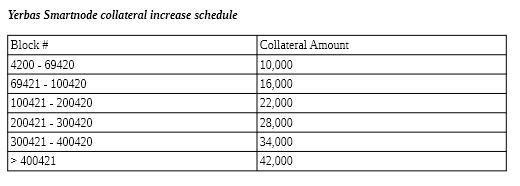
Yerbas is a digital peer-to-peer network that focuses on a specific blockchain application: the efficient transfer of assets between parties. It is built on a fork of the Bitcoin code and was launched on May 9, 2022, as a completely open-source project without an initial coin offering (ICO) or pre-mining. The project prioritizes the development of useful technology within a strong and growing community.
How Yerbas Works
Yerbas aims to optimize asset transfers, including token exchanges, across a global user base. The network integrates several key modifications from its Bitcoin codebase:
- Issuance Schedule: Initial block reward is set at 100 YERB.
- Block Time: Blocks are produced every 123 seconds.
- Total Coin Supply: The supply is capped at 420 million YERB.
- Mining Algorithm: It uses the GhostRider algorithm, which is designed to prevent mining centralization.
- On-chain Asset Creation: Allows for the creation and transfer of customized user-generated information.
Mining Innovations
The GhostRider algorithm, a blend of x16r from Raven and CryptoNight from Monero, is crucial for Yerbas. This algorithm provides necessary randomness and memory requirements to discourage ASIC and FPGA development, which are often barriers to decentralization. Yerbas has implemented two algorithm forks to maintain fairness and prevent ASIC dominance, and no further forks are currently planned.
Unique Characteristics of Yerbas
- ASIC/FPGA Resistance: The GhostRider hashing algorithm discourages the development of specialized mining hardware, promoting mining accessibility.
- Fair Launch: Yerbas was made equally available to all from day one without any pre-mining or ICO, ensuring a fair start.
- Reward Distribution: Mining rewards are distributed as 75% to miners, 20% to Smartnode operators, and 5% to development.
- Smartnode System: The project uses a tiered smartnode collateral and reward system to prevent hyperinflation, a common issue with projects that use Masternodes.
Community and Governance
Yerbas is community-driven and committed to true open-source principles. This ensures that the project remains transparent and aligned with the needs of its users. The community actively participates in decision-making processes, particularly concerning technical updates and network governance.
Wallet Setup
Installer
- Download the latest release [here][#setup] or on GitHub
- Run the installer (.exe or .dmg) and follow the steps
- Run the YerbasCore Daemon (yerbasd)
- Open the wallet
- CLI Run yerbas-cli.exe from the command line to use
- GUI Run yerbas-qt.exe to open
- Allow Daemon to Sync (Use the bootstrap package)
Binaries
- Download the latest release [here][#setup] or on GitHub
- Extract the archive to your desired location
- Run the YerbasCore Daemon (yerbasd)
- Open the wallet
- CLI Run yerbas-cli from the command line to use
- GUI Run yerbas-qt to open
- Allow Daemon to Sync (Use the bootstrap package)
SmartNodes
Smartnodes are integral to Yerbas, handling smart contract storage and execution separately from blockchain blocks, which significantly enhances scalability and reduces issues like those seen in Ethereum. Key benefits include:
- Improved Scaling: Offloads smart contracts from the blockchain, preventing bloat and maintaining performance as the network expands.
- Enhanced Security: Decentralized execution across nodes improves security and reduces breach risks.
- Greater Resistance to 51% Attacks: Diversifies node functions, complicating potential attacks and increasing network robustness.
- Support for Larger Smart Contracts: Enables more complex contracts due to dedicated node resources.
- Flexibility in Programming: Supports various programming languages, inviting a broader developer community.
These optimizations make Yerbas Smartnodes a robust solution for modern blockchain challenges, promoting efficiency, security, and developer inclusivity.
To operate a Yerbas Smartnode effectively, you must have a server that can reliably run the necessary software and maintain stable connections to the network. There are specified minimum requirements to ensure the smooth operation of a Smartnode, although no maximum limits are prescribed.
For optimal performance, it is advisable to deploy a Smartnode on a high-performance Virtual Private Server (VPS) or a dedicated bare-metal server. These hosting environments provide the robust infrastructure needed to support the demands of a Smartnode.
Recommended specifications
- 2 CPU cores without SMT or hyperthreading
- 4 GiB of RAM
- 20 GiB of hard drive space
- Appropriate swap disk space
- 1GBase-T Ethernet connection
Using Solid State Drive powered storage (SATA or NVMe) is highly recommended.
Operating system
Officially supported OS:
- Ubuntu 20.04
- ubuntu 22.04
Using any other OS may result in unexpected behavior and PoSe bans. Installing dependencies VIA Aptitude is only needed if building Yerbascore from source, if using released binaries it should not be needed.
Collateral Schedule

Mining, Rewards & Emissions
At every 1,000,000 blocks, Yerbas has implemented a custom reward structure that not only makes Yerb emissions smooth, but also unique.
Block reward emission schedule:
| Block# | Blockreward | Miner Reward | Smartnode Reward | Dev Reward |
|---|---|---|---|---|
| 0 – 420 | 4.2 | 4.2 | 0 | 0 |
| 421 – 1,000,000 | 100 | 75 | 20 | 5 |
| 1,000,001 – 2,000,000 | 80 | 60 | 16 | 4 |
| 2,000,001 – 3,000,000 | 70 | 52.5 | 14 | 3.5 |
| 3,000,001 – 4,000,000 | 50 | 37.5 | 10 | 2.5 |
| 4,000,001 – 5,000,000 | 40 | 30 | 8 | 2 |
| 5,000,001 – 6,000,000 | 20 | 15 | 4 | 1 |
| 6,000,001 – 7,000,000 | 10 | 7.5 | 2 | 0.5 |
| 7,000,001 – 8,000,000 | 9 | 6.75 | 1.8 | 0.45 |
| 8,000,001 – 9,000,000 | 8 | 6 | 1.6 | 0.4 |
| 9,000,001 – 10,000,000 | 7 | 5.25 | 1.4 | 0.35 |
| 10,000,001 – 11,000,000 | 6 | 4.5 | 1.6 | 0.3 |
| 11,000,001 – 12,000,000 | 5 | 3.75 | 1. | 0.25 |
| 12,000,001 – 13,000,000 | 4.20 | 3.15 | 0.84 | 0.21 |
| 13,000,001 – 14,000,000 | 3 | 2.25 | 0.6 | 0.15 |
| 14,000,001 – 15,000,000 | 2 | 1.5 | 0.4 | 0.1 |
| 15,000,001 – 16,000,000 | 1 | 0.75 | 0.2 | 0.05 |
| 16,000,001 + | 0.420 | 0.315 | 0.084 | 0.021 |
Yerbas uses an algorithm code named GhostRider. The GhostRider algorithm is a Proof of Work (PoW) mining algorithm employed by certain cryptocurrencies to ensure fair and decentralized distribution of mining operations. While it is tailored to be ASIC and FPGA resistant, it is amenable to both CPU and GPU mining. Here’s a brief overview of its functionality:
- Algorithm Combination: It blends the randomization features of x16r from RavenCoin and the memory-intensive process of CryptoNight from Monero.
- Randomness in Hashing: The x16r component uses a random sequence of 16 different hashing algorithms, determined by the hash of the previous block. This unpredictability prevents the efficiency gains that ASICs would typically have.
- Memory Usage: By incorporating elements from CryptoNight, GhostRider requires significant memory during the mining process, which is a deterrent for ASIC development due to the cost and complexity of incorporating substantial memory into ASIC chips.
- Dynamic Adjustments: GhostRider can adapt its parameters in real-time to counteract the introduction of ASICs or FPGAs, maintaining a level playing field for all miners.
- Mining Accessibility: Though designed to discourage ASICs, GhostRider remains accessible for mining with consumer-grade CPUs and GPUs. Popular mining software like SRBMiner and WildRig Miner can be utilized to mine coins with this algorithm, ensuring that a broader base of users can participate in the mining process with the hardware they already possess.
The fact that anyone anywhere can contribute to the network and earn should increase the projects decentralization, unlike networks where ASIC are present or GPU have such a large advantage that CPUs become obsolete.
This coin project can be mined using CPU or GPU’s. Download one of the following CPU/GPU miners. Most of these miners can be used in Windows/Linux and Hive
- XMRIG CPU Mining : Github Release Page
- Cpuminer-gr : Github Release Page
- SRB Miner Multi (Supports CPU+AMD/Nvidia GPU’s) Windows/Linux/Hive : Github Release Page
- WildRig Multi (Supports AMD/Nvidia GPU’s) Windows/RaveOS/Linux/Hive: Github Release Page
you can mine this coin on our pool www.pmpmining.com
